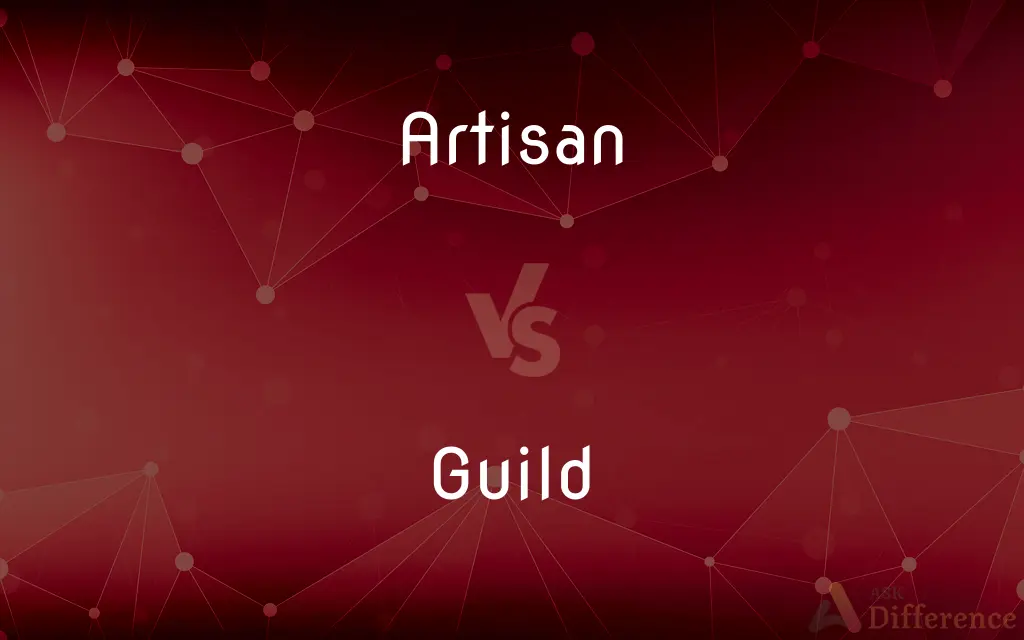Artisan vs. Guild — What's the Difference?
By Tayyaba Rehman & Maham Liaqat — Updated on April 4, 2024
An artisan is a skilled craftsperson, while a guild is an association of craftsmen in the same trade.

Difference Between Artisan and Guild
Table of Contents
ADVERTISEMENT
Key Differences
Artisans and guilds are both integral to the history and practice of craftsmanship, yet they occupy distinct roles within the ecosystem of trade and craftsmanship. An artisan is an individual who possesses specialized skills in a particular craft or trade, often producing handcrafted goods with a high degree of craftsmanship. Guilds, on the other hand, are organizations or associations that bring together artisans and craftsmen from the same trade or craft, often to regulate standards, protect interests, and provide support to their members.
Artisans are known for their expertise and the quality of their work, crafting items ranging from pottery and jewelry to furniture and clothing. Their work is characterized by a personal touch and attention to detail, distinguishing it from mass-produced items. Guilds, while, serve as collective entities that support artisans through training, regulation, and advocacy, ensuring that the trade's standards are maintained and that the craftsmen's rights and interests are protected.
The relationship between artisans and guilds is symbiotic. Artisans benefit from the structure, support, and regulation provided by guilds, which in turn help in preserving the quality and integrity of the craft. Guilds offer a framework within which artisans can operate, providing mechanisms for apprenticeship, dispute resolution, and market regulation. This structure helps maintain the economic viability and cultural significance of traditional crafts.
Historically, guilds played a crucial role in the economic and social fabric of medieval and early modern societies, regulating trades and crafts to ensure quality, manage competition, and provide for their members' welfare. Artisans, as individual practitioners of these crafts, relied on the guilds for access to markets, protection under the law, and the preservation of their craft's standards and techniques.
Today, the concept of guilds has evolved, but their foundational principle of supporting skilled craftsmanship through collective effort and regulation continues in various forms, including professional associations and trade unions. Artisans, while increasingly operating within a globalized and digitized market, still maintain the ethos of craftsmanship, individuality, and quality that defines their work.
ADVERTISEMENT
Comparison Chart
Definition
A skilled craftsperson who creates handcrafted goods.
An association of craftsmen in the same trade, regulating standards and protecting interests.
Focus
Individual craftsmanship and quality of work.
Collective support, regulation, and advocacy for craftsmen.
Role
Production of handcrafted items with a personal touch.
Support and regulate the trade, ensuring quality and fairness.
Benefit
Known for expertise and attention to detail in their craft.
Provides structure, support, and protection to artisans.
Historical Significance
Individual practitioners of crafts, contributing to cultural and economic life.
Played crucial roles in regulating trades and supporting craftsmen in society.
Compare with Definitions
Artisan
An individual with specialized skills in a craft.
An artisan may create unique pottery pieces by hand.
Guild
Advocates for the rights and interests of its members.
Guilds could negotiate better terms for their members' products.
Artisan
Their work is characterized by attention to detail and personal touch.
Each piece an artisan produces is distinct and reflects their skill.
Guild
Ensures the quality and integrity of the craft are maintained.
Guilds would inspect goods and certify them for sale.
Artisan
Produces items ranging from jewelry to furniture.
Artisans often use traditional techniques to create their goods.
Guild
An organization that supports artisans within the same trade.
A weavers' guild might set standards for cloth quality.
Artisan
Their work contributes to both the economy and the preservation of cultural traditions.
Artisans help keep traditional crafts alive in modern times.
Guild
Provides a framework for training, standards, and dispute resolution.
Guilds historically managed apprenticeships to train new craftsmen.
Artisan
Typically operates independently, though they may collaborate with others or be part of associations.
Many artisans sell their goods at local markets or through online platforms.
Guild
Played a significant role in the social and economic organization of trades.
In medieval cities, guilds were powerful entities that regulated commerce.
Artisan
An artisan (from French: artisan, Italian: artigiano) is a skilled craft worker who makes or creates material objects partly or entirely by hand. These objects may be functional or strictly decorative, for example furniture, decorative art, sculpture, clothing, food items, household items and tools and mechanisms such as the handmade clockwork movement of a watchmaker.
Guild
A guild is an association of artisans and merchants who oversee the practice of their craft/trade in a particular area. The earliest types of guild formed as organizations of tradesmen, belonging to: a professional association, a trade union, a cartel, and/or a secret society.
Artisan
A person skilled in making a product by hand.
Guild
A medieval association of craftsmen or merchants, often having considerable power.
Artisan
Made by hand or by traditional means and using high-quality ingredients; artisanal
Artisan cheeses.
Artisan wine.
Guild
An association of persons of the same trade or pursuits, formed to protect mutual interests and maintain standards.
Artisan
A skilled manual worker who uses tools and machinery in a particular craft.
Guild
A similar association, as of merchants or artisans, in medieval times.
Artisan
A person who displays great dexterity.
Guild
(Ecology) A group of species in a community that use similar environmental resources in a similar way, such as a group of songbirds that all glean insects from leaves.
Artisan
Artisanal
Guild
A group or association mainly of tradespeople made up of merchants, craftspeople, or artisans for mutual aid, particularly in the Middle Ages.
Artisan
One who professes and practices some liberal art; an artist.
Guild
A corporation.
Artisan
One trained to manual dexterity in some mechanic art or trade; and handicraftsman; a mechanic.
This is willingly submitted to by the artisan, who can . . . compensate his additional toil and fatigue.
Guild
(ecology) A group of diverse species that share common characteristics or habits.
Artisan
A skilled worker who practices some trade or handicraft
Guild
(video games) An organized group of players who regularly play together in a multiplayer game.
Guild
An association of men belonging to the same class, or engaged in kindred pursuits, formed for mutual aid and protection; a business fraternity or corporation; as, the Stationers' Guild; the Ironmongers' Guild. They were originally licensed by the government, and endowed with special privileges and authority.
Guild
A guildhall.
Guild
A religious association or society, organized for charitable purposes or for assistance in parish work.
Guild
A formal association of people with similar interests;
He joined a golf club
They formed a small lunch society
Men from the fraternal order will staff the soup kitchen today
Common Curiosities
What is a guild?
An association or organization that brings together craftsmen from the same trade to regulate standards and protect their interests.
Can artisans work outside of guilds?
Yes, artisans can and do work independently, especially in modern contexts where traditional guild structures may not exist.
How do artisans benefit from guilds?
Guilds provide artisans with support, regulation, and advocacy, ensuring fair trade practices and quality standards.
What is an artisan?
A skilled craftsperson who produces handcrafted goods, often with traditional methods.
How were disputes resolved within guilds?
Guilds had mechanisms for internal dispute resolution, often through arbitration or guild courts.
What role did guilds play historically?
They regulated trades, ensured quality, managed competition, and provided for the welfare of their members.
What distinguishes an artisan's work?
The individual craftsmanship, quality, and unique characteristics of their products.
Are guilds still relevant today?
While traditional guilds are less common, the principles of collective support and regulation are continued by modern professional associations and trade unions.
How do artisans sell their products?
Through various channels including local markets, online platforms, and specialty stores.
How do artisans contribute to the economy?
Through the production and sale of unique, handcrafted goods, artisans contribute to local economies and the preservation of cultural heritage.
What challenges do modern artisans face?
Competition with mass production, maintaining relevance in a digital age, and securing fair compensation for their work.
Can anyone become an artisan?
With the necessary skills, dedication, and creativity, anyone can work towards becoming an artisan in their chosen craft.
What benefits do guilds offer to consumers?
By regulating standards, guilds help ensure that consumers receive high-quality and fairly priced goods.
How did guilds impact medieval society?
They were integral to the economic, social, and political fabric, influencing trade practices, quality standards, and even local governance.
What’s the difference between an artisan and a guild?
An artisan is an individual skilled craftsperson, while a guild is a collective organization that supports and regulates craftsmen within a trade.
Share Your Discovery

Previous Comparison
Conciseness vs. Concision
Next Comparison
Linotype vs. MonotypeAuthor Spotlight
Written by
Tayyaba RehmanTayyaba Rehman is a distinguished writer, currently serving as a primary contributor to askdifference.com. As a researcher in semantics and etymology, Tayyaba's passion for the complexity of languages and their distinctions has found a perfect home on the platform. Tayyaba delves into the intricacies of language, distinguishing between commonly confused words and phrases, thereby providing clarity for readers worldwide.
Co-written by
Maham Liaqat















































